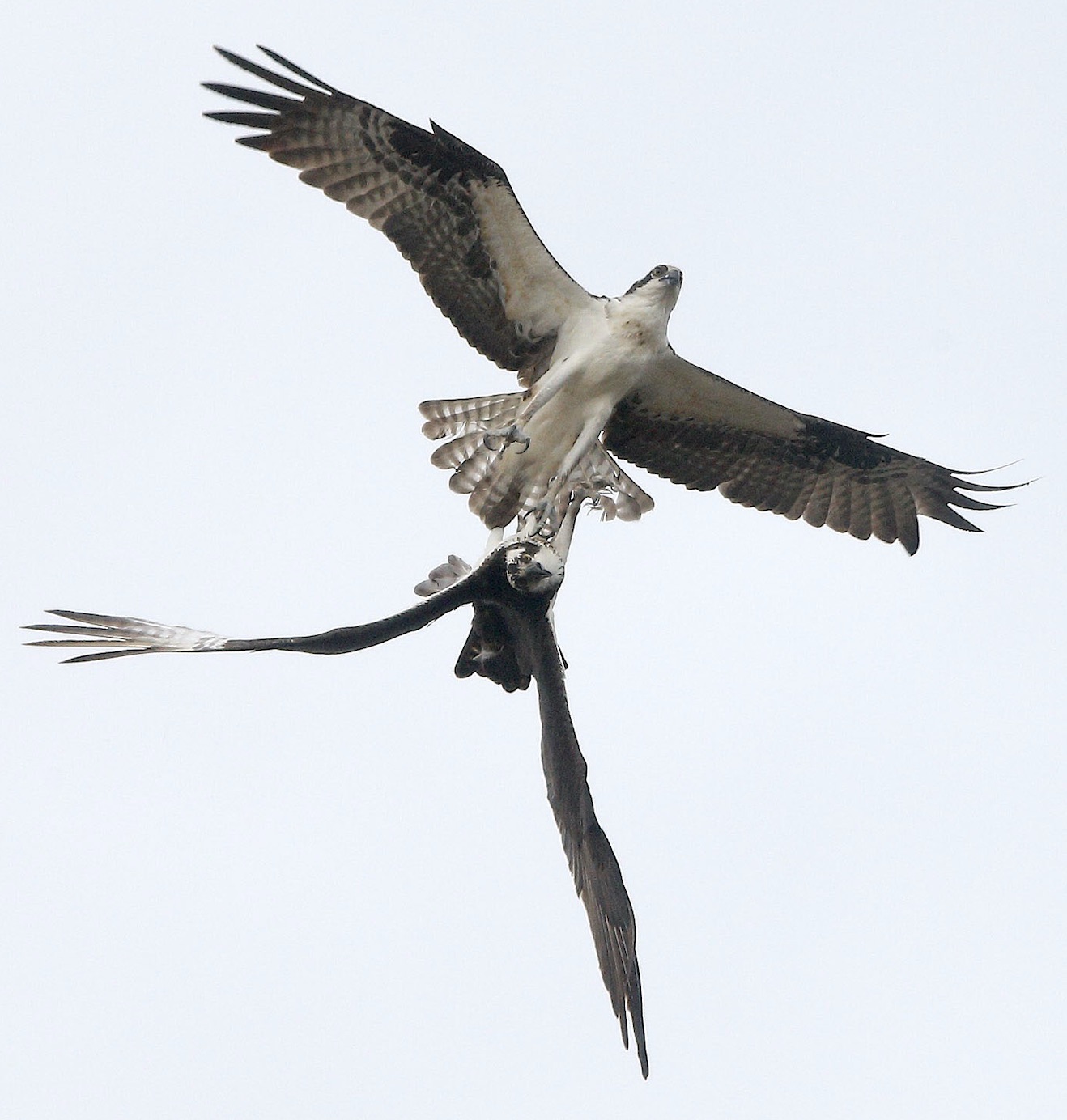
Two ospreys fighting over a territory in the spring of 2021. This is not like the talon-locking courtship display of eagles - this is real battle, and these birds are indeed trying to hurt each other.
|
In
the spring of 2021, at the very end of February, I noticed a lone osprey (my first of the year) checking out an old nest beside Falls Lake in North Carolina. Two weeks later I went back, and found that the site was already occupied by a pair of ospreys, who were now fiercely defending their territory.
The photo above shows two birds in aerial battle. The bird on top is one of the residents of the site, while the lower bird is one of several interlopers. Zooming in on the photo shows that both birds are reaching out with their very sharp talons toward the other bird's body. This is not like the talon-locking courtship display of eagles. This is armed conflict. Over the course of several hours I witnessed many such altercations. At one point I saw no fewer than five ospreys flying around the nest site. A juvenile bald eagle also made an appearance: |
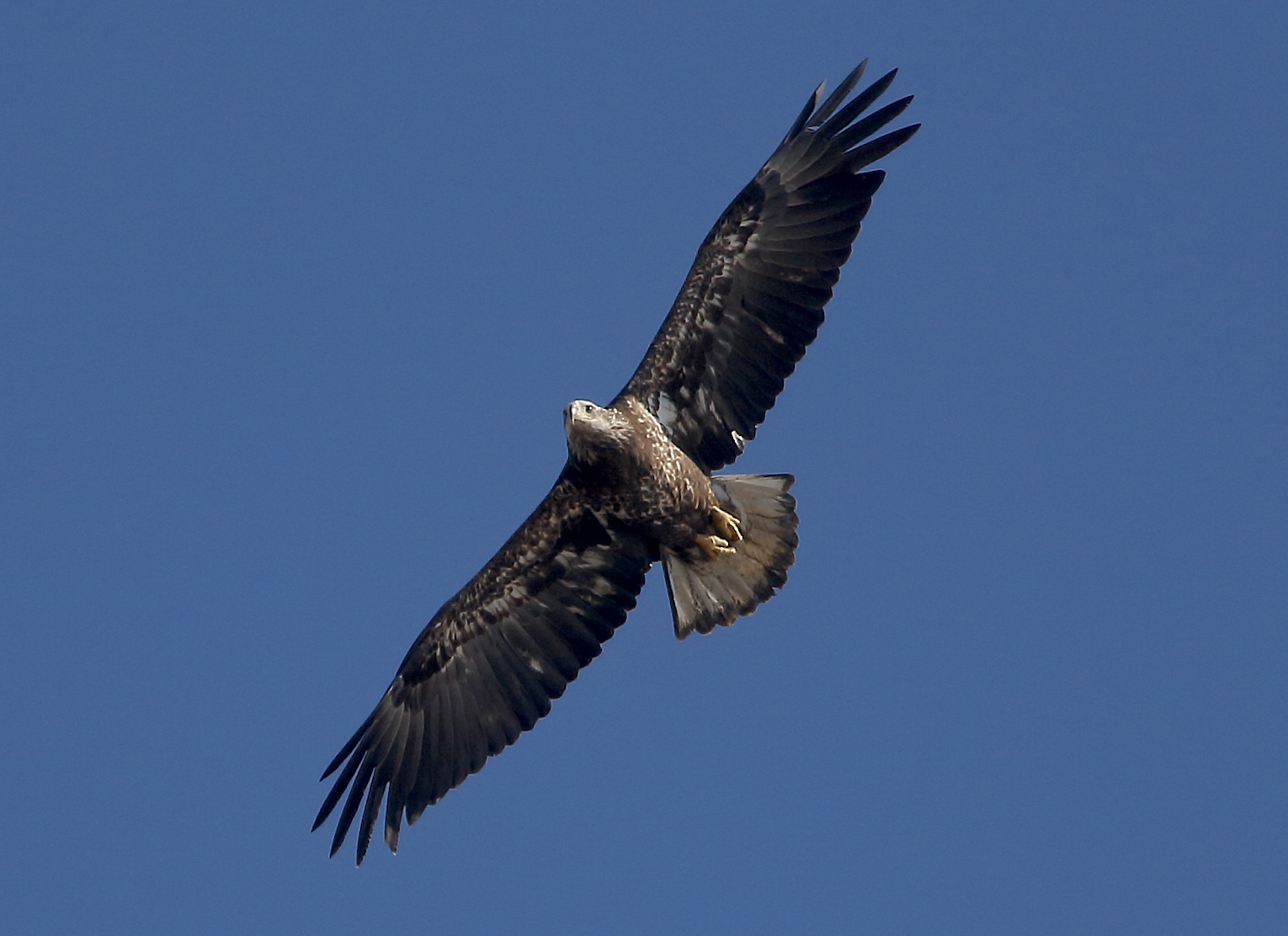
A juvenile bald eagle who wandered into the territory of the ospreys. |
The eagle was not spared the wrath of the ospreys. Though I wasn't able to capture both the osprey and the eagle in the same frame, the photo below shows the eagle rolling over in mid-air to protect itself from an osprey diving at it from above:
|
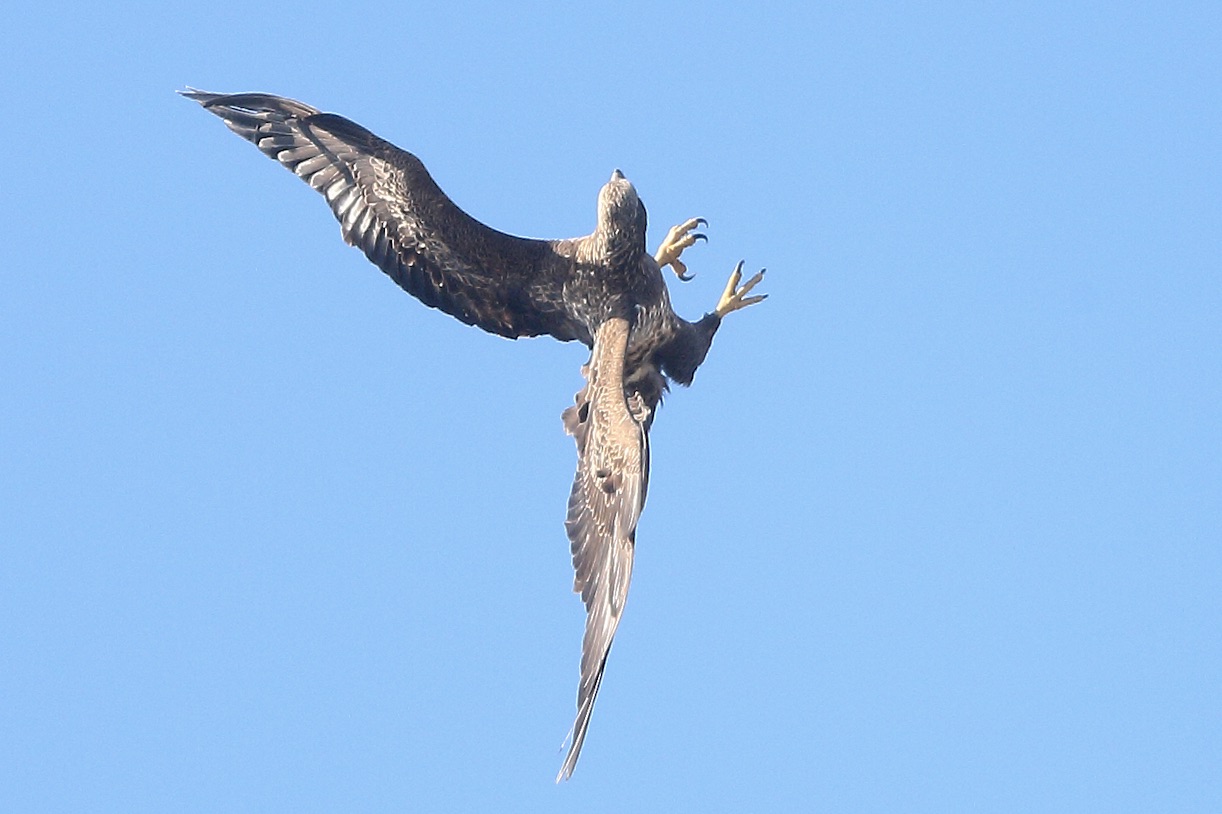
Juvenile bald eagle rolling over onto its back in mid-air and extending its talons, to protect it from an osprey diving at it from above. |
The land bordering the lake here consists of open fields, which attract red-tailed hawks who hunt for rodents. But in the immediate vicinity of the osprey nest, red-tails are not welcome. Late in the afternoon I even saw one of the ospreys chase off a turkey vulture that tried to perch too close.
|
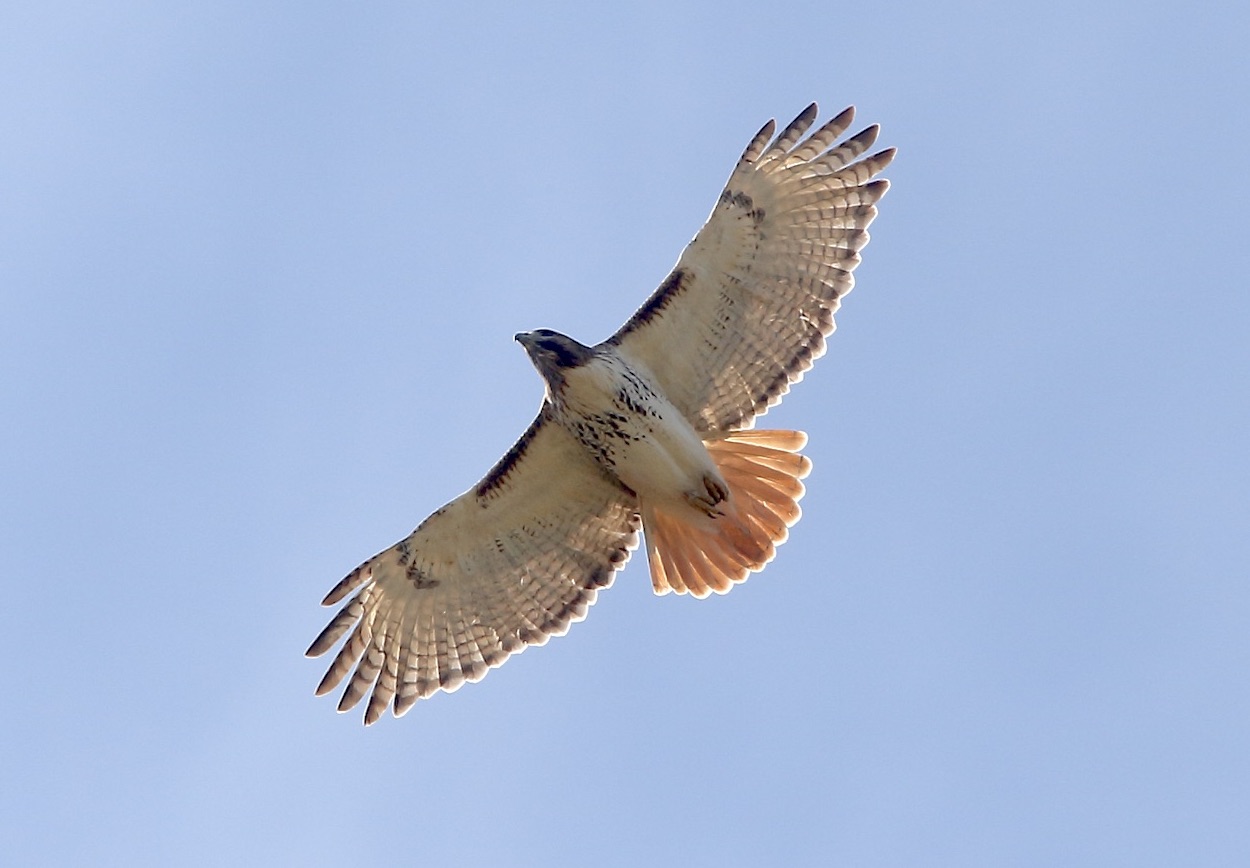
Red-tailed hawk soaring over the fields bordering the lake.
|
This nest site is a bit unusual, in that the nest itself is located on top of a massive steel structure supporting the powerlines that run across the lake here. Ospreys are known to be more willing than many other raptors to use artificial structures for their nest sites.
This has been beneficial in the past. After osprey numbers were substantially reduced during the DDT years due to the effects of pesticides, many artificial nesting platforms were constructed to provide ospreys with additional nesting sites. Because bald eagles tend to prefer shaded spots for their nests, these artificial sites out in the open provide an opportunity to the ospreys, since they don't have to compete with the eagles for them. |
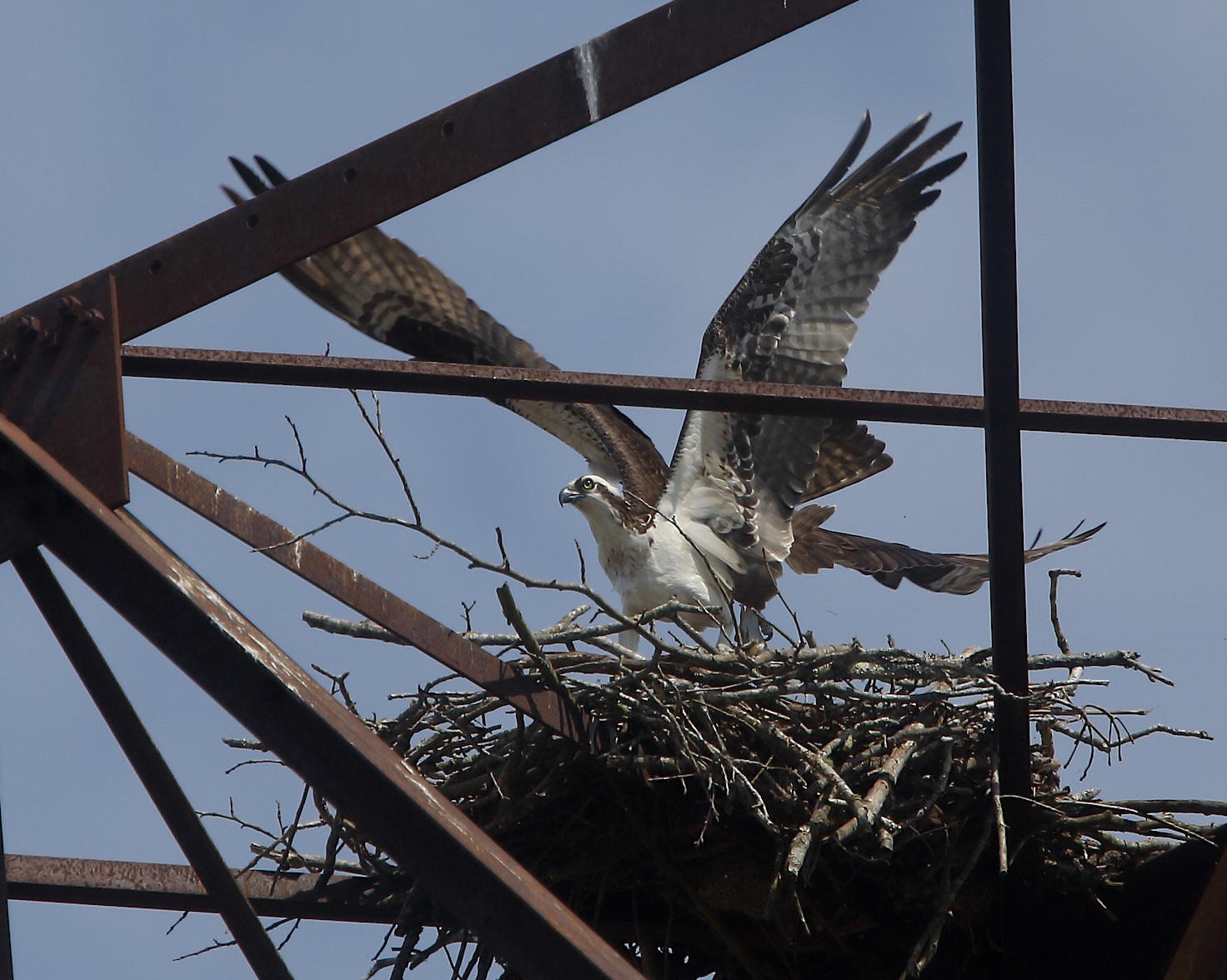
The ospreys' nest is at the very top of a massive steel structure supporting the powerlines that cross the lake here. Unfortunately, the nest is so high that it's difficult to get detailed images even with a 560 mm lens.
|
In the photo below, you can see that the steel structure on which these ospreys have their nest is very tall - taller than the surrounding trees. The view from the top must be spectacular, and would allow the ospreys to see far in every direction as they keep a lookout for threats such as other raptors. They can also watch the surface of the lake for fish.
|
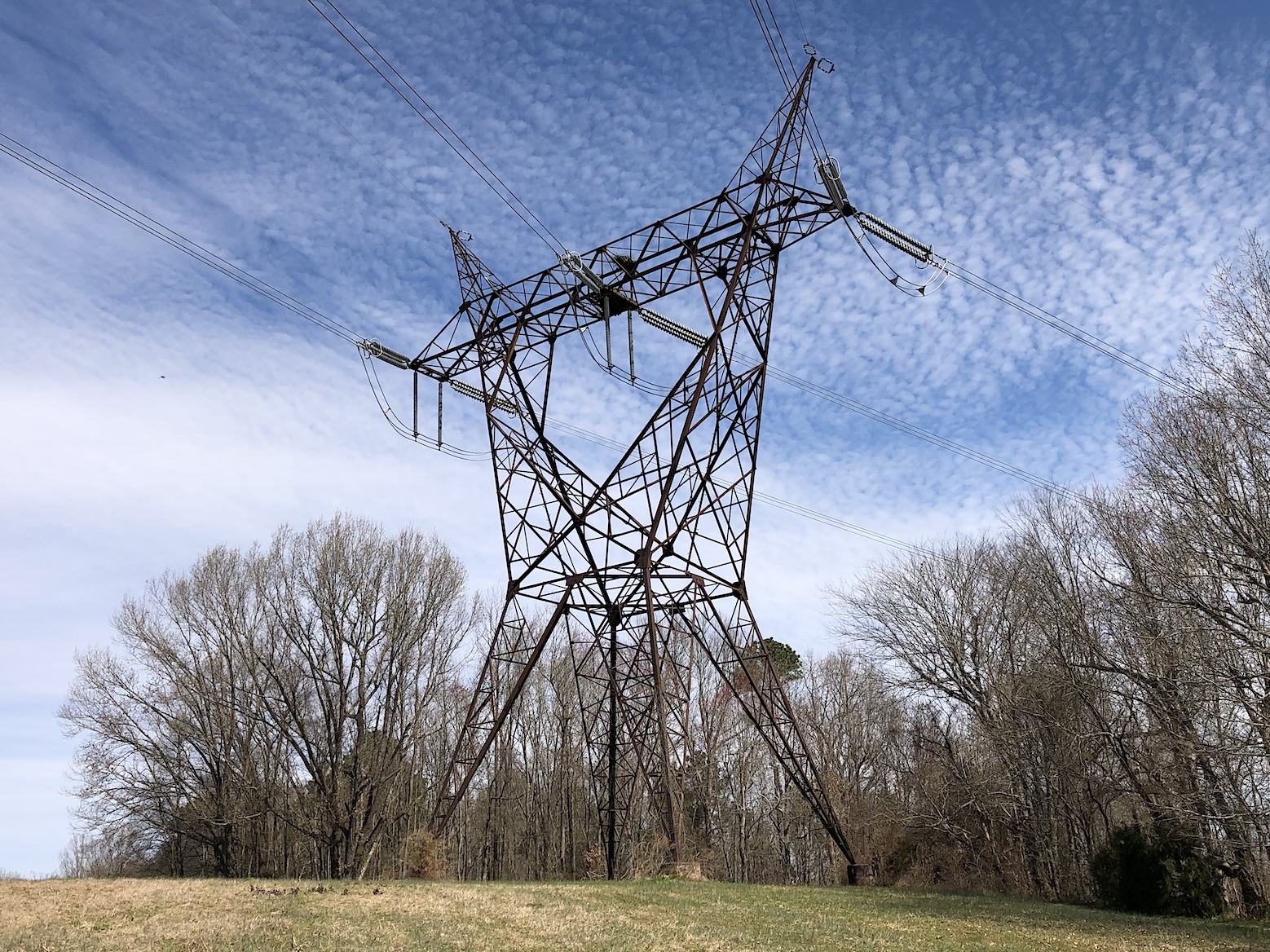
The pylon supporting the powerlines is taller than the trees around it. Having their nest atop this structure means that the birds can see for a great distance in every direction - useful for keeping a lookout for danger, or for watching the lake surface for fish.
|
The height of the nest at this site does make photographing the birds difficult - as do the power lines and the steel structure, which tend to get in the way when I try to shoot the birds in flight. Because some hiking is required to get to the site, I use a small, 400 mm lens, which is very portable and handy for flight shots. But because the birds fly fairly high here, I use a 1.4x teleconverter to get more magnification (effectively 560 mm).
Shooting birds in flight is always challenging. With a 560 mm focal length, just finding the bird in the viewfinder and keeping it in frame during flight can be difficult. All of that magnification helps to bring out more details in the bird, but makes it harder for tracking a moving subject. |
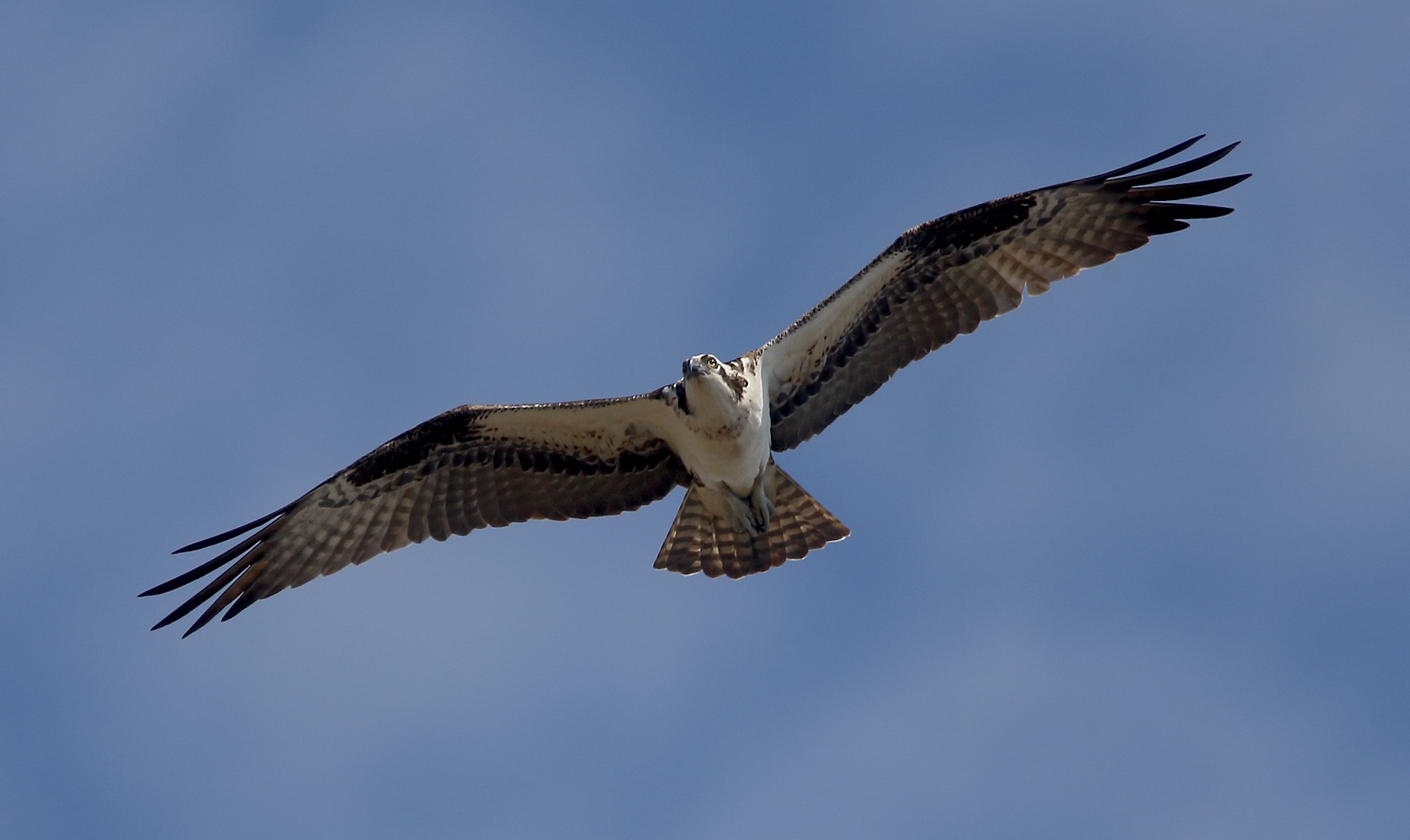
Getting frame-filling shots of birds in flight is very difficult. You need a large focal length to magnify the birds, but then it becomes challenging to track the bird in the viewfinder and to keep from clipping the bird's wings. And long telephoto lenses get very heavy after a while. After a long day of shooting birds in the field, my whole body hurts.
|
An added challenge here is that during most daylight hours the birds are lit from above, whereas I'm shooting them from below. That makes exposure very difficult, because the birds are back-lit, and they're too far for flash. To make matters worse, the black-and-white plumage of ospreys is difficult to expose properly without losing detail in either the whites or the blacks.
One trick is to wait until the birds bank during flight, allowing the sun to light up their underside. In the photo below, the bird is turned sideways, so that some of the underside is exposed to direct sunlight. But the lighting is still uneven, and you can see that I over-exposed one of the white patches. Fortunately, using the highlight alerts in your camera, you can see when you're blowing the highlights and dial down the exposure until the highlight alerts stop blinking. I find this to be a very effective technique. |
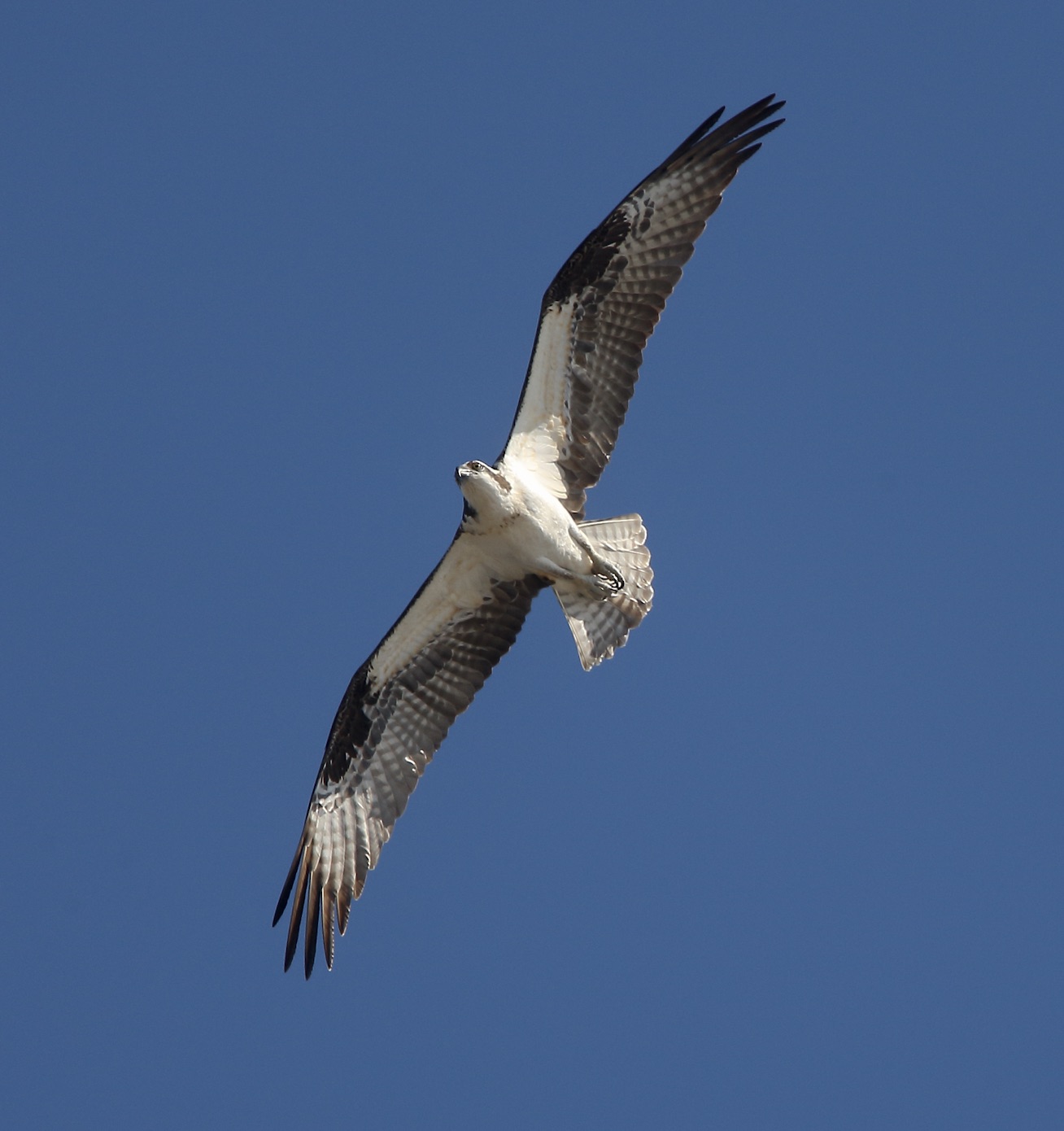
When the sun is above the bird, you'll mostly get belly shots of a back-lit subject. One trick is to wait until the bird banks, letting the sun hit its underside. But be careful not to overexpose the lighter areas, because you'll lose details. I use my camera's highlight alerts to tell me when I'm clipping the highlights.
|
Earlier in the morning the skies had been very gray, and you can see in the photo below that this severely limited my exposure options, resulting in little more than a silhouette. In this case I intentionally overexposed a little, in hopes of bringing out some of the colors, though it only had a slight effect in the osprey on the left. Highlight alerts helped here too, though: I turned up my exposure until the only flashing in my highlight alerts was in the background, since I didn't want to overexpose the birds, but I didn't care if I overexposed the background.
|
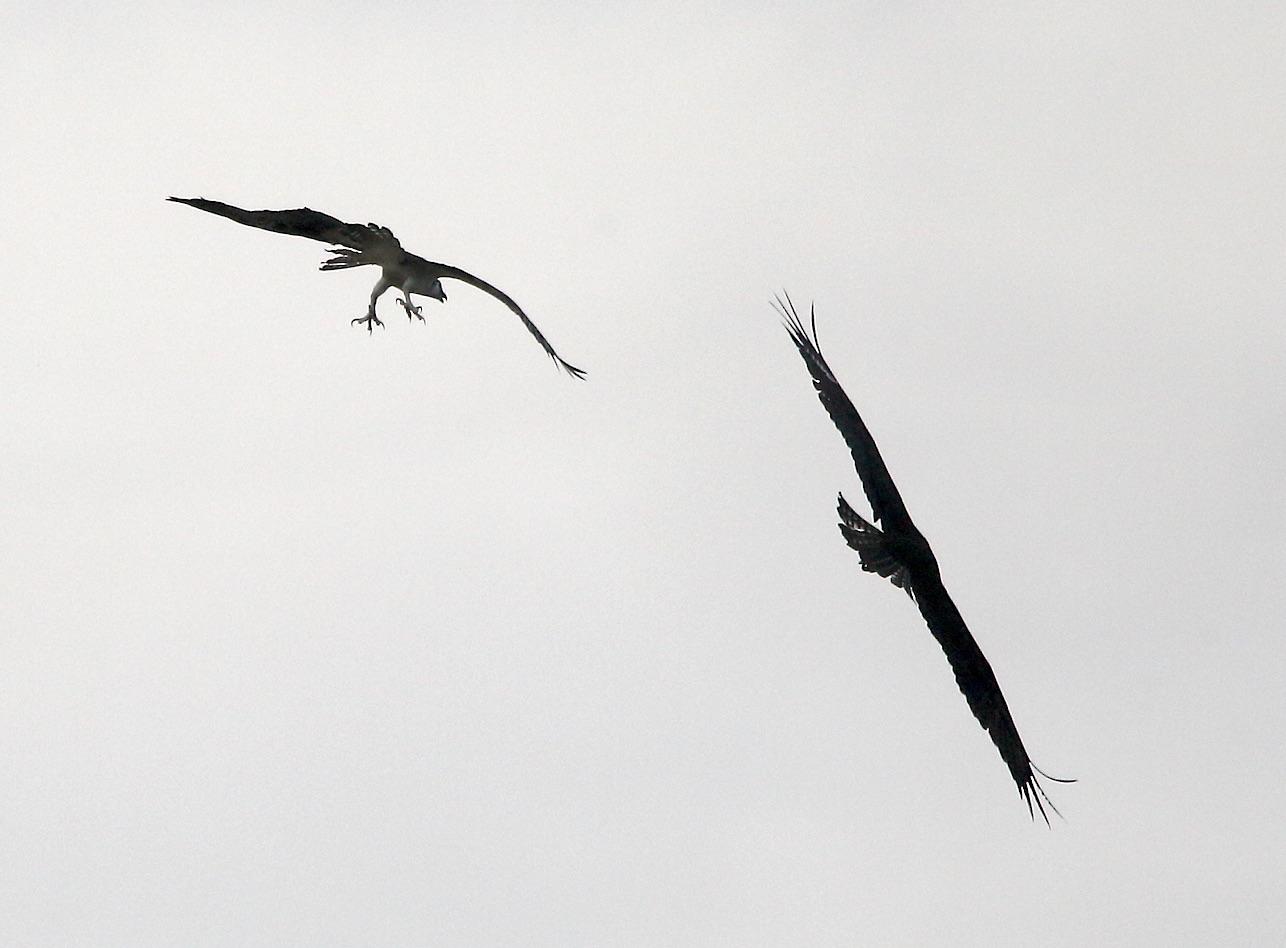
On dark days, sometimes the best you can do is to take silhouette shots. In this case I was able to do a little better by slightly overexposing, to reveal some of the color patterning in the bird. Using my camera's highlight alerts, I turned up the exposure until the background was overexposed, but the bird wasn't.
|
The other critical issue when shooting birds in flight is the accuracy of your camera's autofocus. All of these photos were taken with my 13-year-old, 10 megapixel crop camera, which, fortunately, has a good autofocus system (though not the best, by today's standards). There are many issues involved in getting the most out of your camera's autofocus system, including using an appropriate autofocus mode and drive mode, selecting appropriate AF points, and making sure your lens is properly calibrated. Keep in mind that using a teleconverter will generally reduce AF speed and accuracy - which was a constant challenge for me in this shoot.
One nice thing about watching a bird nest is that you can observe many different types of behaviors at and around the nest. In addition to warding off intruders, I also observed the birds bringing in nest materials to further build up the structure. Ospreys and other raptors such as eagles often add more material to the nest every year, so that over time the nest can become quite large. |
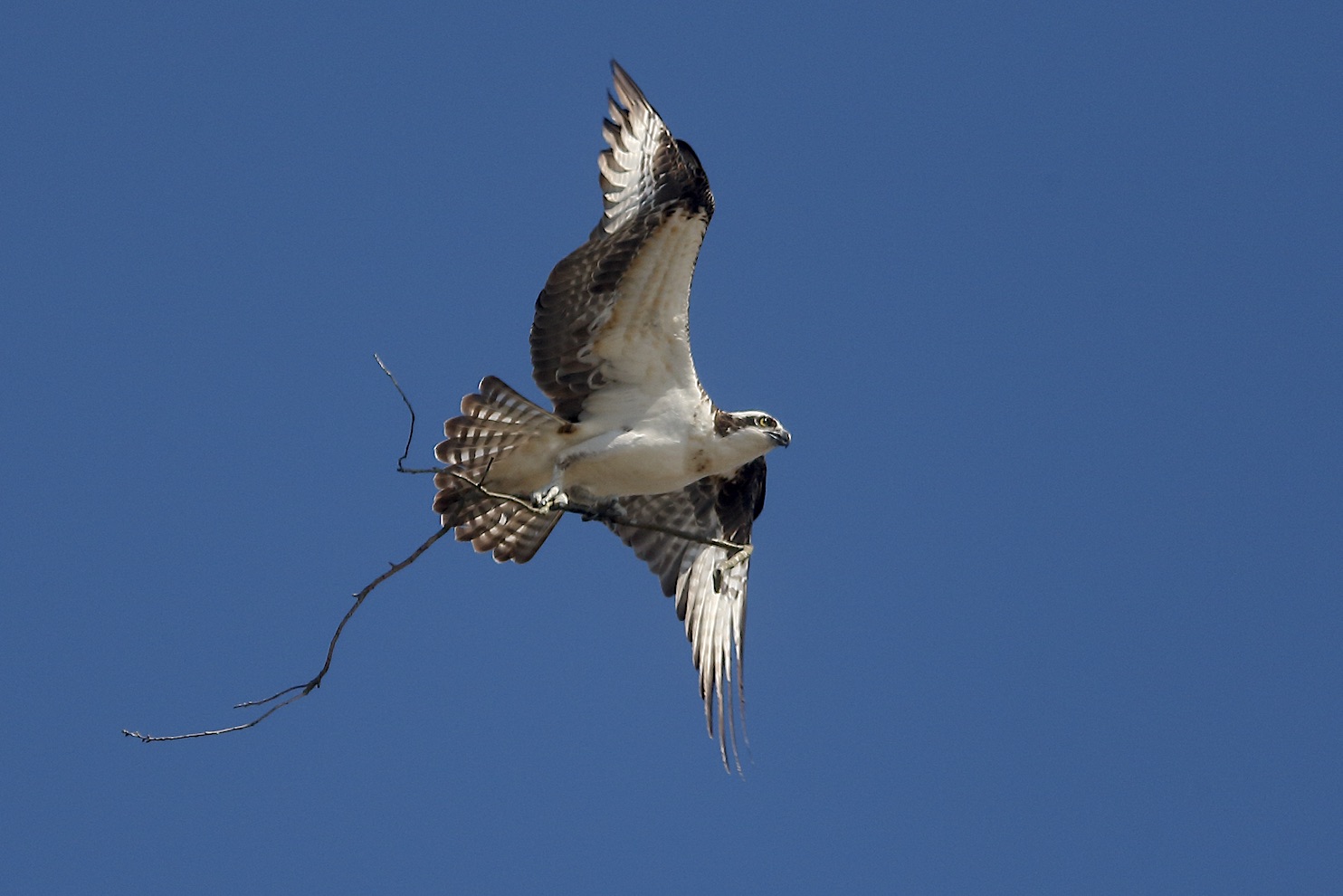
One of the resident ospreys bringing a stick to the nest. Many raptors will add a bit of material to the nest every year, and in some cases the nests can get quite large over time.
|
Nests can also rot. In 2007 I spent an entire season watching an osprey nest site. In that year, the nest rotted to the point that it ended up falling out of the nest tree. Unfortunately, the chicks couldn't yet fly, so they had to cope with living in a tree with no nest. Even if the nest doesn't rot, the tree it's in can - as happened to an eagle nest I was watching in 2006, on this same lake. That would be one more advantage to building a nest on a steel powerline structure - though I'm not sure the ospreys know that.
Returning to the challenge of shooting birds in flight, when you can't use flash to freeze your subject, you need to use high shutter speeds. For me, since I use manual exposure (rather than my camera's automatic exposure modes), that involves setting my aperture to wide open (which was f/5.6 for all of these shots), setting my ISO to the highest level at which my camera can produce relatively noise-free images (around ISO 1250 for my 13-year-old camera), and then turning up my shutter speed until the highlight alerts stop blinking. That's the brightest exposure that doesn't clip any highlights. By setting aperture to wide open and my ISO as high as is practical, I'm also maximizing shutter speed. |
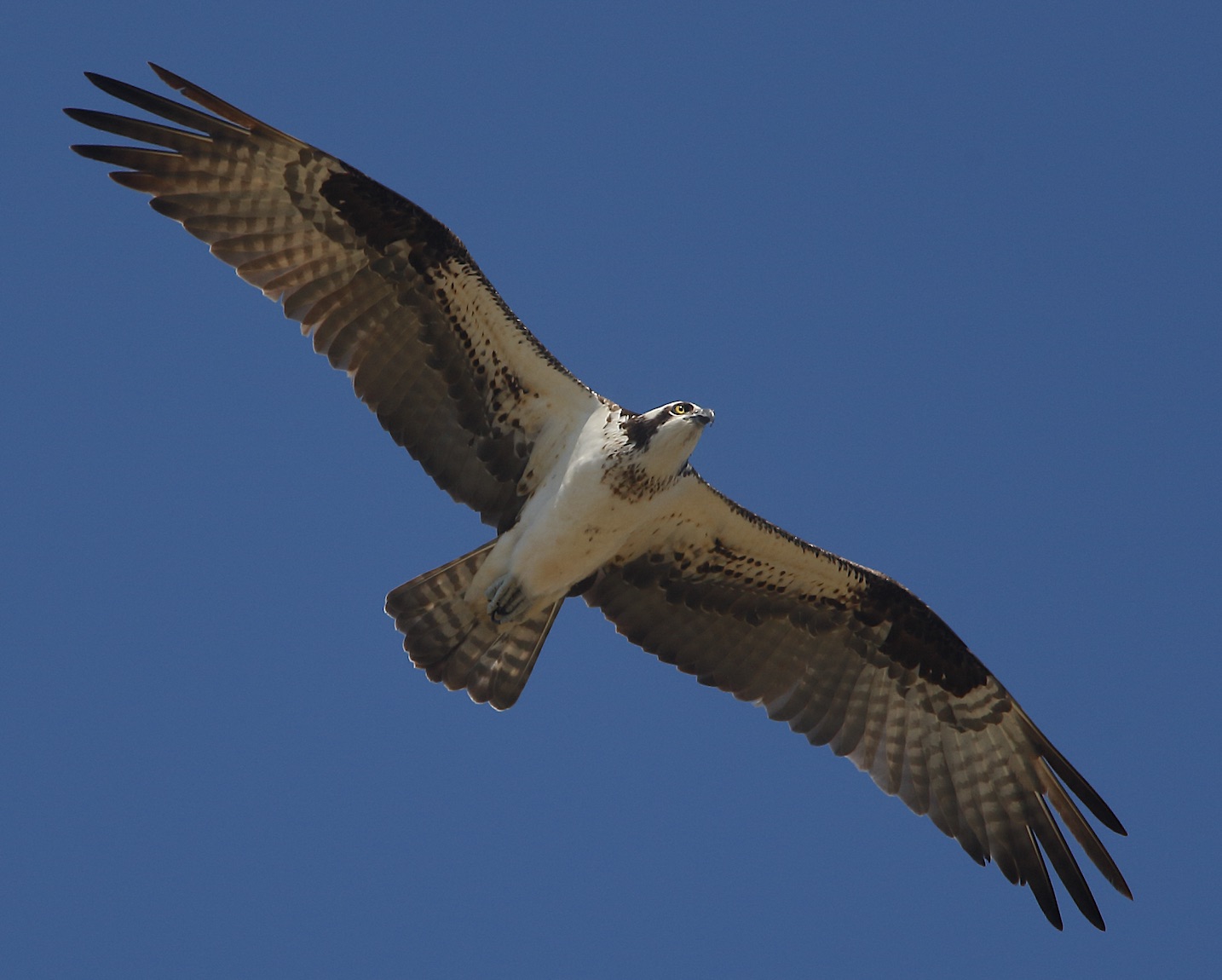
Another shot of a back-lit bird. When post-processing these types of shots, I typically apply an exposure correction to reduce the highlights and to increase exposure in shadows. Photoshop can do this, as can various free software tools, such as the Preview tool in OS X.
|
For many of these photos I was shooting at 1/8000 sec - a very fast shutter speed. That seemed to freeze the birds quite well in most cases. However, when the light was dimmer I had to shoot at slower speeds of around 1/1000 sec, which can still result in some blurry images. Keep in mind that for hummingbirds, since they flap their wings so much faster than large birds like ospreys, you can have more luck freezing the motion via flash - though you need to be close.
The nice thing about fast motion photography is that you can sometimes catch the birds in an awkward pose, which can make for a more interesting photo. |
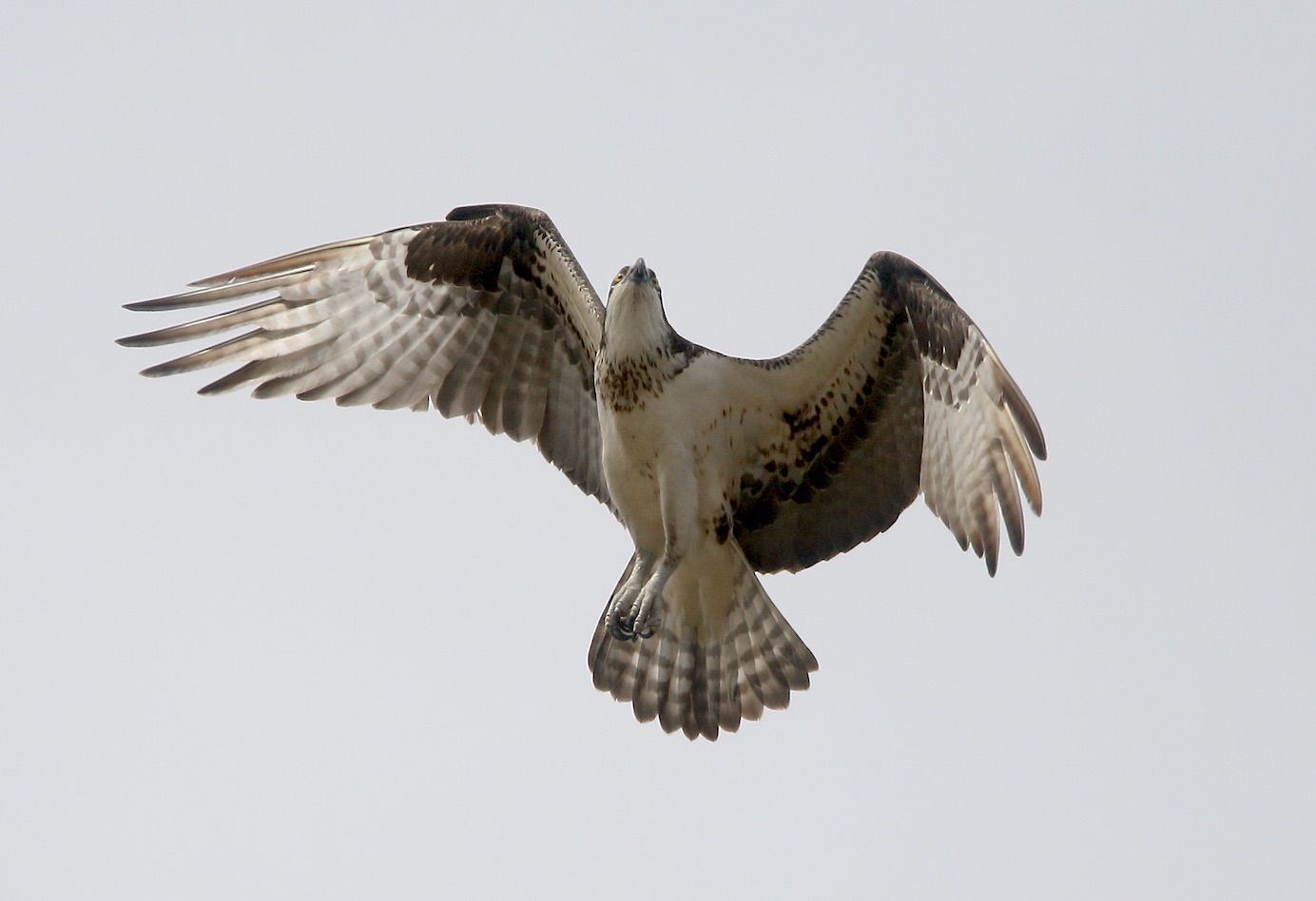
Fast motion photography can sometimes catch birds in an awkward pose, which often makes for an interesting photo.
|
I look forward to continuing my monitoring of this nest. Future updates will be posted to my web site at www.ThirdBirdFromTheSun.com, under the "blog" tab.
|
| FREE eBooks by W.H. Majoros: |
|
CLICK TO DOWNLOAD FREE PDF |
CLICK TO DOWNLOAD FREE PDF |